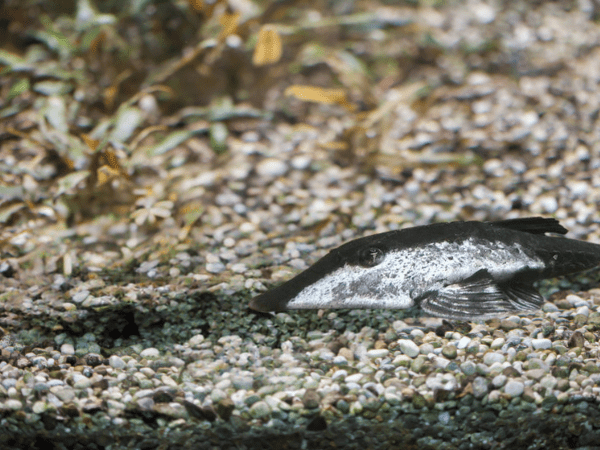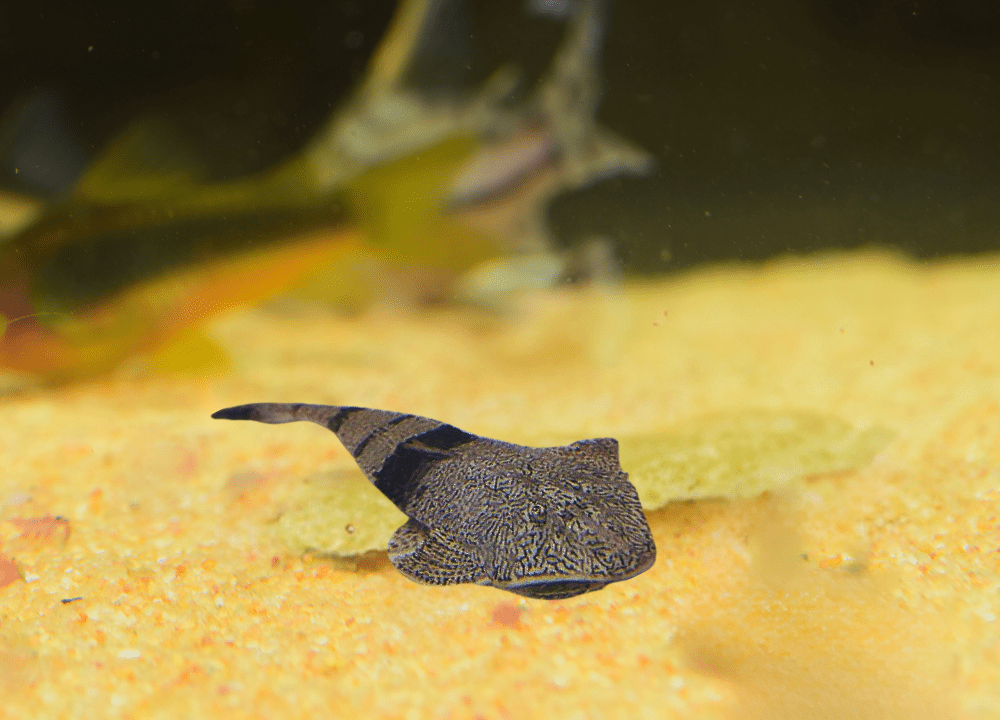The Pseudohemiodon apithanos, is a unique catfish species. It’s renowned for its ability to change color to blend with its environment.
Originating from South American rivers, the Pseudohemiodon Apithanos thrives in soft, acidic water with a sandy substrate, mimicking its natural habitat. Aquarium enthusiasts admire this bottom-dweller for its distinct appearance and color-changing ability. Typically reaching up to 5. 5 inches in length, this peaceful fish suits well-planted tanks where it can forage and exhibit natural behaviors.
Its diet mainly consists of plant matter and small invertebrates. Successful care for Pseudohemiodon apithanos involves maintaining clean water with low light and gentle filtration, creating an ideal environment for these captivating creatures to flourish.
Table of Contents
Physical Characteristics Pseudohemiodon Apithanos
The Pseudohemiodon apithanos, flaunts a mesmerizing anatomy. This aquatic wonder captures the hearts of fish enthusiasts worldwide. A closer look at its body structure and coloration reveals why it’s adored.
Body Structure
The body of the Pseudohemiodon apithanos is indeed a marvel of nature. Streamlined and flat, this remarkable fish is perfectly adapted to life at the bottom of streams. Its underside is almost flat, which aids in creating a sucking effect. This effect keeps it securely attached to surfaces even in strong currents.
Noted for its elongate form, this species can grow to impressive sizes. Adults may reach up to 20 centimeters in length.
- Elongated, flattened shape
- Specialized mouth for attachment
- Size up to 20 cm in adults
Coloration And Markings
The Pseudohemiodon apithanos’s beauty is highlighted by its distinctive color patterns. Markings on its skin are not just visually stunning but provide excellent camouflage against the riverbed. These markings are usually dark brown or black, streaked over a lighter brown or sandy background.
Unique body markings define the visual appeal of the Pseudohemiodon apithanos. Each fish boasts a unique set of spots and stripes, making them as individual as fingerprints.
Key Coloration Features
| Base Color | Sandy to light brown |
| Markings | Dark brown or black |
| Pattern | Spots and stripes, unique to each fish |
Collectors and fish admirers find the Pseudohemiodon apithanos to be a fascinating addition to their tanks. Its distinctive physical traits not only make it a striking spectacle but also reflect the marvels of evolutionary adaptation.
Behavioral Traits
Discover the intriguing behaviors of the captivating Pseudohemiodon apithanos. Commonly known as the Pseudohemiodon apithanos, this fish exhibits a complex range of behaviors that reflect its unique lifestyle in the wild. Observing these creatures can provide aquarists a deeper understanding and appreciation of their distinctive character.

Feeding Habits
In the realm of gastronomy, Pseudohemiodon apithanos showcases particular feeding habits. They are known to have a preference for soft bottoms, where they can forage for their meals.
- Suction feeders – using their mouths like a vacuum
- Feast on biofilm and small invertebrates
- Attach to surfaces to scrape food
Social Behavior
Interactions within their own kind and with other fish are complex. The Pseudohemiodon apithanos is typically a peaceful companion in a diverse aquarium setting.
| Condition | Behavior |
|---|---|
| Lone or in groups | Prefer living solitarily but adjust in small groups |
| Aquarium mates | Tolerate other species; avoid fin nippers |
| Spawning season | Show territorial instincts |
Tank Setup And Care
Creating a cozy home for Pseudohemiodon apithanos, commonly known as the Loricariidae, requires attention to detail. Their unique needs make tank setup a crucial step in fostering a healthy environment. Let’s dive into the specifics that will make your whiptail catfish thrive.
Water Parameters
Water quality tops the list of essentials for the well-being of Pseudohemiodon apithanos catfish. These freshwater natives prefer a habitat that mimics their natural environment. Aim for soft to moderately hard water, with temperatures between 72 and 79°F (22-26°C).
Regular water changes keep their environment fresh. A balance in pH levels, ranging from 6.5 to 7.2, is ideal for these bottom dwellers. Keeping ammonia and nitrite levels at zero, and nitrates low, will help prevent stress and diseases.
| Parameter | Value |
|---|---|
| Temperature | 72-79°F / 22-26°C |
| pH Level | 6.5-7.2 |
| Water Hardness | Soft to Moderate |
Dietary Requirements
Pseudohemiodon apithanos are not picky eaters. They enjoy a varied diet. In the wild, they primarily feed on biofilm and small organisms. In captivity, balancing their diet with high-quality sinking pellets and wafers is key. Complement their meals with live or frozen foods like bloodworms or daphnia.
- Alternate between pellets and wafers.
- Include live or frozen treats.
- Observe eating habits to avoid overfeeding.
Remember to feed your fish twice a day. Give them only as much as they can consume in a few minutes. This minimizes waste and maintains water quality. And, most importantly, healthy, happy fish!

Breeding And Reproduction Pseudohemiodon Apithanos
Welcome to our deep dive into breeding and reproduction of the Pseudohemiodon apithanos. This fascinating fish is a wonder in the aquarium community due to its unique breeding behaviors and processes. Let’s uncover what makes the reproductive journey of this species so intriguing.
Courtship Behavior
The courtship dance of the Pseudohemiodon apithanos is a sight to behold. Males exhibit vivid colors and perform a series of moves to attract females. This includes fin flicking, body quivering, and chasing. Observing these fish during courtship can add excitement to any aquarium experience.
Spawning Process
Once a pair forms, the spawning process begins. It occurs in a unique manner:
- Selecting a Site: Couples choose a surface, often a flat stone or a leaf.
- Egg Laying: The female lays her eggs in neat rows.
- Fertilization: Males then fertilize the eggs externally.
- Guarding: Males guard the site persistently until hatching.
Hatchlings emerge in about a week, depending on temperature. The juvenile fish require clean water and specialized care to thrive.
Challenges And Conservation
The majestic Pseudohemiodon apithanos, faces trials in the wild that threaten its survival. Understanding the challenges and taking action for conservation are vital. These delicate creatures need our attention and aid to ensure their future.
Threats In The Wild
The Pseudohemiodon apithanos grapple with several threats in their natural habitats. Key dangers include:
- Habitat loss due to deforestation for agriculture and urbanization.
- Water pollution from industrial and chemical runoff.
- Overfishing for the aquarium trade.
- Climate change affects water levels and temperatures.
Conservation Efforts
To safeguard these unique fish, concerted conservation efforts are underway. They involve:
- Setting up protected areas within their natural range.
- Enforcing laws to prevent illegal collection and trade.
- Research programs to monitor populations and health.
- Educational outreach to local communities.
Only through understanding and action can we hope to preserve the Pseudohemiodon apithanos for future generations to marvel at.
View All TYPES OF CATFISH
Frequently Asked Questions For Pseudohemiodon Apithanos
How Do You Take Care Of A Pseudohemiodon Apithanos Catfish?
Provide a well-filtered tank with hiding spots for your chameleon whiptail catfish. Maintain stable water conditions, with a temperature range of 75°-79°F and a pH of 6. 5-7. 5. Offer a varied diet including algae, bottom-feeder pellets, and blanched vegetables.
What Is The Natural Habitat Of Pseudohemiodon Apithanos?
Pseudohemiodon Apithanos, naturally inhabits murky river bottoms in South America. They thrive in soft, sandy substrates where they can easily burrow.
How Big Does Pseudohemiodon Apithanos Get?
The Pseudohemiodon Apithanos can reach up to 6 inches in length. Its size makes it suitable for medium-sized aquariums.
What Does Pseudohemiodon Apithanos Eat?
In the wild, Pseudohemiodon Apithanos is a benthic feeder, primarily consuming biofilm, detritus, and small invertebrates. In captivity, they accept various sinking foods, including pellets and wafers.
Conclusion
Exploring the Pseudohemiodon apithanos has been quite the journey. This intriguing fish, with its flat body and unique camouflaging ability, adds mystery to any aquarium. Hobbyists seeking a rare species will find the Pseudohemiodon Apithanos a rewarding challenge. Remember, its well-being hinges on specific care, mirroring its natural habitat.
Embrace the chance to observe this living work of art in your own aquatic gallery.


